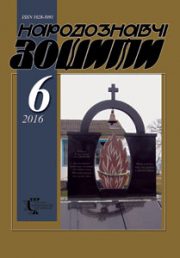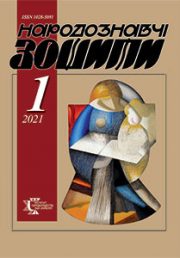The Ethnology Notebooks. 2022. № 1 (163), 36—49
UDK: 7.041:27-526.62-312.47]:7.025.4
DOI https://doi.org/10.15407/nz2022.01.036
DRUZYUK Halyna
- ORCID ID: https://orcid.org/0000-0002-7168-8362
- senior researcher, Lviv National Academy of Arts,
- Department of Restoration of Art Objects,
- 38, Kubiyovycha Street, 79011, Lviv, Ukraine,
- Contacts:e-mail: dobrogroza@gmail.com
SKOP Mykhailo
- ORCID ID: https://orcid.org/0000-0001-5901-8211
- postgraduate student,
- Lviv National Academy of Arts,
- 38, Kubiyovycha Street, 79011, Lviv, Ukraine,
- Contacts: e-mail: neivanmade@gmail.com
Abstract. The article considers the icon of «Virgin Hodegetria» from the Kamyanka-Buzka district of the Lviv region of the XVII century. The relevance of the topic lies in the comprehensive analysis of the art object, which is studied for the first time. The study focuses on a detailed examination of the artistic style of the monument. In particular the most characteristic features that may indicate the authorship of Ivan Rutkovych are considered in the article. The author analyzes iconography and researches of an icon that served as a model.
The aim of the article is to investigate the artistic features and iconography of the icon «Virgin Hodegetria» from Kamyanka-Buzka district, to prove the authorship of Ivan Rutkovych. For this purpose there where used such methods as formal-stylistic, comparative, method of iconographic analysis, method of reconstruction, method of research of cultural context.
The object of research is the icon «Virgin Hodegetria» from Kamyanka-Buzka district. The subject of research is artistic features, attribution and iconography. As a result of the research it was found that the monument has artistic features that correspond to the works of Ivan Rutkovych in the 70s of the XVII century. More than fifty Ukrainian icons of the XVIth—XVIIIth centuries with similar iconography were also found. Based on art and historical sources, it was established that all examples of this iconography could be derived from the Vilniaus Dievo Motinos icon. The appendices provided a description of the icon for restoration and a list of restoration processes.
Keywords: Ivan Rutkovych, Virgin Hodegetria, Theotokos of Vilnius, iconography, Leontiy Tarasevych, Zhovkva School of Icon Painting, Restoration of Easel Painting, Iconostasis, Ukrainian Icon Painting, Vilniaus Dievo Motinos.
Received 13.01.2022
REFERENCES
- Dragan, M. (1970). Ukrainian decorative carvings of XVI—XVIII centuries. Kyiv: Naukova Dumka [in Ukrainian].
- Sventsitska, V. (1966). Ivan Rutkovych and the formation of realism in Ukrainian painting of the XVII century. Kyiv: Naukova dumka [in Ukrainian].
- Zholtovsky, P. (1968). Icon painting. History of Ukrainian art: in 6 vols. (Vol. 3, pp. 193—239). Kyiv: URE [in Ukrainian].
- Ovsiychuk, V. (1991). Masters of the Ukrainian Baroque: Zhovkva Art Center. Kyiv: Naukova dumka [in Ukrainian].
- Ovsiychuk, V. (1996). Ukrainian painting of the X—XVIII centuries. Color problems. Lviv: Institute of Ethnology of the National Academy of Sciences of Ukraine [in Ukrainian].
- Alexandrovych, V. (2012). Rutkovych Ivan. Encyclopedia of the History of Ukraine: in 10 vol. (Vol. 9, pp. 403—944). Kyiv: Naukova dumka [in Ukrainian].
- Alexandrovych, V. (2004). Ivan Rutkovych and Zhovkva painting center of the late XVII century. Sights of Ukraine: history and culture (Part 1, pp. 90—101) [in Ukrainian].
- Alexandrovych, V. (1994). Two documents to the beginning of the biography of Ivan Rutkovych. NTS Notes (Pp. 372—378). Lviv [in Ukrainian].
- Skop, P. (2021). Aesthetic features of the iconostasis of Ivan Rutkovych Church of the Archangel Michael from the village of Stara Skvaryava. BULLETIN of the Lviv National Academy of Arts, 21, 155—165 [in Ukrainian].
- Skop, P. (2006). Influences of European style Mannerism on the work of Ukrainian artists of the XVII century. Bulletin of the Lviv branch of the National Research and Restoration Center of Ukraine, 2 (8), 22—27 [in Ukrainian].
- Skop, P. (2016). Iconographic and stylistic features of the icon «Apotheosis of the Virgin of Pechersk» in 1712 by painter Ivan Rutkovych, from the collection of the Lviv Museum of the History of Religion. History of religions in Ukraine (Ch. 2, pp. 537—548). Lviv [in Ukrainian].
- Skop-Druzyuk, G., & Skop, P. (2009). Iconostasis of the XVI—XVIII centuries from the village of Staraya Skvaryava. Lviv: Logos [in Ukrainian].
- Skop, P. (2004). Works by Ivan Rutkovych in the collection of LMIR. History of religion in Ukraine. Materials of sciences conference (Vol. 2, pp. 610—615). Lviv [in Ukrainian].
- Skop, P. (2003). Ivan Rutkovych, author of the icon «Exaltation of the Holy Cross» from the village of Sytykhiv. Ukrainian Greek Catholic Church and Religious Art (Pp. 148—150). Lviv; Rudno [in Ukrainian].
- Skop, P. (2008). Creativity of Ivan Rutkovych in the light of new research. Bulletin of the Lviv National Academy of Arts (Pp. 195—203). Lviv [in Ukrainian].
- Stepovik, D.V. (1986). Leontiy Tarasevych and Ukrainian Baroque art. Kyiv: Naukova dumka [in Ukrainian].
- Tomalska, J. (2012). The history of one monument. Icon of Our Lady of Bielsko. Bialoruskie Zeszyty Historyczne (Vol.36, pp. 23—40) [in Polish].
- Tomalska-Wiecek, J. (2020). Maria shrines in Podlasie. Small cities. Canonical Spirituality (Pp. 133—221). Bialystok: Futoma-Suprasl [in Polish].
- Janocha, M. (2008). Russian Icons of Hodegetria. Salvatoris Mater, 10/1, 153—172 [in Polish].
- Janoniene, R. (2019). The icon of Our Lady of Vilnius and its cult of Svc. Trinity churches. Art studies, 1 (Vol. 24). Riklius T. Mislingas Vilniaus Mergeles Marijos atvaizdas (NZ-A nr. 2). Geg 9, 2019. Retrieved from: https://nzidinys.lt/tomas-riklius-mislingas-vilniaus-mergeles-marijos-atvaizdas-nz-a-nr-2/ (Last accessed: 21.12.2021) [in Lithuanian].
- Pelekh, M. (2012). Apostolic theme of the little-known iconostasis of the XVII century. Transfiguration Church in the village of Smolyn (Yavoriv region) Apologist, 32Ї33. Proceedings of the V International Conference in Lviv, November 23—24, 2012. «Christian sacred tradition: Faith, spirituality, art». Theological collection of the Lviv Theological Academy of the UOC-KP (Pp. 108—111). Lviv [in Ukrainian].
- Otkovych, T. (2012). Elements of the Mannerist style in the carving of Ukrainian iconostasis of the XVII century. Apologist. Materials of V sciences. conf. (Christian sacred tradition: faith, spirituality, art; November 23—24, 2012. Lviv Orthodox Theological Academy) (Pp. 150—154). Lviv [in Ukrainian].
- Tradigo, A. (2005). Icons. Masterpieces of the Eastern Church. Picture dictionary of art (Vol. 9, p. 169). Parthas Verlag; Berlin [in German].
- Skop, L. (2004). Painter of the icon of the Virgin Hodegetria from Mrazhnytsia. Lviv: Logos [in Ukrainian].
- Kosiv, R. (2019). Rybotytsky Center for Church Art 1670—1760. Lviv: Andrei Sheptytsky National Museum in Lviv [in Ukrainian].
- Image of the miraculous image of the Blessed Virgin of Vilnius. Fragment of an engraving. The second half of the XVIII century. From the meeting of A.V. Olsufyeva [From a series of 130 icons of the Blessed Virgin]. Federal State Budgetary Institution «Russian National Library». Retrieved from: https://kp.rusneb.ru/item/material/5fcf8c5f991f3b91423467c3 (Last accessed: 21.12.2021) [in Russian].
- (1848). The image of the Icons of the Blessed Virgin, glorified in the Orthodox Church. Moscow [in Russian].
- (2005). Grand Duchy of Lithuania. Encyclopedia (Vol. 1). Minsk: Belarusian Encyclopedia [in Belarusian].







